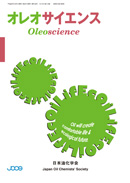
- |<
- <
- 1
- >
- >|
-
Hiroki NAKANISHI2014Volume 14Issue 8 Pages 321-327
Published: 2014
Released on J-STAGE: February 01, 2017
JOURNAL FREE ACCESSLipids has very important and various functions in the body. For examples, lipids are the major constituents of cellular membranes and the most efficient source of energy in living organisms. In addition, lipid molecules also work directly as bioactive molecules in immune self-defense and the maintenance of homeostasis. Traditional techniques such as thin layer chromatography, liquid chromatography and gas chromatography are widely used for lipid analysis. However, these methods are difficult for the analysis of molecular species and they require at nanomolar levels of sample. In recent years, because of the development of mass spectrometry technology, analytical methods for quantifying lipids and their metabolites have led to progress in the number of detectable molecular species and their sensitivity. This analytical technique is called the lipidomics. Lipidomics is an emerging field to investigate the structures, functions and dynamic changes of lipids in cells, tissues or body fluids. We aim at the elucidation of a biological phenomenon by global and/or specific comprehension of biological lipids using lipidomics. In this review, we present the analytical technique and the future vision for lipidomics.
View full abstractDownload PDF (831K) -
Yoshihiro IZUMI, Eiichiro FUKUSAKI, Takeshi BAMBA2014Volume 14Issue 8 Pages 329-336
Published: 2014
Released on J-STAGE: February 01, 2017
JOURNAL FREE ACCESSLipids consists of several hundreds to thousands of molecular lipid species with diverse chemical and structural properties that constitute membranes, store metabolic energy, and function as signalling molecules. Recently, comprehensive quantitative analysis of lipids, i.e., lipidomics, is used as a powerful tool for medical science, pharmaceutical research, food, and biotechnology. A supercritical fluid is a substance whose temperature and pressure are above their critical values, and it possesses features such as low viscosity and high diffusivity. Therefore, it exhibits suitable properties for usage in the mobile phase of chromatography and extraction solvent. Supercritical fluid chromatography (SFC) is characterized by high resolution at high flow rate. On the other hand, supercritical fluid extraction (SFE) has been effectively applied to extract easily oxidized compounds without pretreatment processes. This review focused on the development of an analytical system for lipidomic analysis by utilizing supercritical fluid technology.
View full abstractDownload PDF (1355K) -
Takuro ITO2014Volume 14Issue 8 Pages 337-342
Published: 2014
Released on J-STAGE: February 01, 2017
JOURNAL FREE ACCESSOil-rich algae are potentially promising as next-generation biofuel feedstock. Oil, principally triacylglycerol (TAG), accumulation has been observed in numerous species or strains of various algal taxa under several different culture conditions, which are nutrient-deficient, chemical stimulus and physical stress. However, the productivity of algal oil needs to be improved for industrial use. The biosynthesis of TAG and its control mechanism have not been characterized in any algae, and understanding the metabolic network is vital to achieve the precise engineering of algae metabolic pathways. In this decade, mass spectrometry-based metabolome analysis has become an important tool for characterizing intracellular metabolic profiles. Metabolome analysis is a useful application for model organisms and for uncommon organisms because it does not require genomics or other “omics” information. Quantitative and qualitative measurements of large numbers of cellular metabolites are useful to elucidate the dynamics of biological systems. The applications of metabolomics to oil-rich algae are introduced in this article.
View full abstractDownload PDF (1383K)
- |<
- <
- 1
- >
- >|